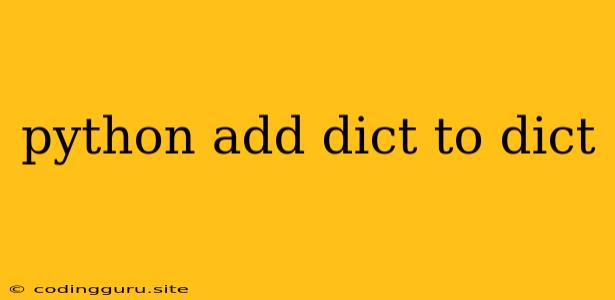How to Add a Dictionary to a Dictionary in Python
In the realm of Python programming, dictionaries are versatile data structures that store key-value pairs. They are particularly useful for representing structured data. But what if you need to combine two dictionaries into a single, unified entity? This is where the concept of adding a dictionary to a dictionary comes into play. Let's delve into this fundamental operation, examining various methods and strategies.
Understanding Dictionaries
Before we embark on the process of adding dictionaries, let's briefly recap the essence of these data structures:
- Key-Value Pairs: Dictionaries are built upon the notion of key-value pairs. Each key must be unique and immutable (like strings, numbers, or tuples). Keys act as identifiers, while values can be any Python object.
- Mutable: Dictionaries are mutable, meaning you can modify their content after their creation. This includes adding, removing, or updating key-value pairs.
- Unordered: Dictionaries do not maintain a specific order for their elements. This is a crucial distinction compared to lists or tuples.
Methods for Adding Dictionaries
Now, let's explore the primary approaches to merging two dictionaries in Python:
1. Using the update() Method
The update() method provides a convenient way to incorporate the key-value pairs from one dictionary into another. Here's how it works:
dict1 = {'a': 1, 'b': 2}
dict2 = {'c': 3, 'd': 4}
dict1.update(dict2)
print(dict1) # Output: {'a': 1, 'b': 2, 'c': 3, 'd': 4}
In this example, the update() method modifies dict1 by adding the key-value pairs from dict2. If a key from dict2 already exists in dict1, its value will be overwritten.
2. Using the ** Operator (Unpacking)
The ** operator, also known as the "unpacking" operator, offers a more elegant and concise approach to adding a dictionary to a dictionary.
dict1 = {'a': 1, 'b': 2}
dict2 = {'c': 3, 'd': 4}
merged_dict = {**dict1, **dict2}
print(merged_dict) # Output: {'a': 1, 'b': 2, 'c': 3, 'd': 4}
This method effectively creates a new dictionary merged_dict by merging the key-value pairs from both dict1 and dict2. The ** operator expands the dictionaries into their individual key-value pairs, allowing for their seamless combination.
3. Using the copy() Method (Preserving the Original)
In situations where you want to preserve the original dictionaries, the copy() method comes in handy.
dict1 = {'a': 1, 'b': 2}
dict2 = {'c': 3, 'd': 4}
merged_dict = dict1.copy()
merged_dict.update(dict2)
print(merged_dict) # Output: {'a': 1, 'b': 2, 'c': 3, 'd': 4}
This approach first creates a copy of dict1 and then updates the copy with the key-value pairs from dict2. This ensures that the original dict1 remains untouched.
Dealing with Duplicate Keys
When merging dictionaries, you might encounter scenarios where both dictionaries have the same key. Python will favor the last occurrence of the key, effectively overwriting the value from the earlier dictionary.
dict1 = {'a': 1, 'b': 2}
dict2 = {'b': 3, 'c': 4}
merged_dict = {**dict1, **dict2}
print(merged_dict) # Output: {'a': 1, 'b': 3, 'c': 4}
In this example, the value of 'b' in dict2 overwrites the value of 'b' in dict1 because dict2 is applied after dict1 in the merging process.
Handling Specific Merge Behavior
If you require more nuanced control over how duplicate keys are handled, you can use the collections.ChainMap class or custom functions.
collections.ChainMap
The ChainMap class allows you to create a "linked" view of dictionaries, where it searches for keys across multiple dictionaries. This can be useful if you want to look up a key in multiple dictionaries without explicitly merging them.
from collections import ChainMap
dict1 = {'a': 1, 'b': 2}
dict2 = {'b': 3, 'c': 4}
chained_map = ChainMap(dict1, dict2)
print(chained_map['b']) # Output: 2 (values from `dict1` are prioritized)
Custom Functions
For complex merging scenarios with specific logic, you can write custom functions that iterate through the dictionaries and apply your desired merging rules.
Conclusion
Adding dictionaries in Python is a fundamental operation that provides a means of combining multiple data sources into a single unified structure. The update(), ** operator, and copy() method offer versatile options for accomplishing this task. Understanding the behavior of duplicate keys and exploring the possibilities of collections.ChainMap and custom functions will empower you to efficiently manage complex dictionary merging operations.
